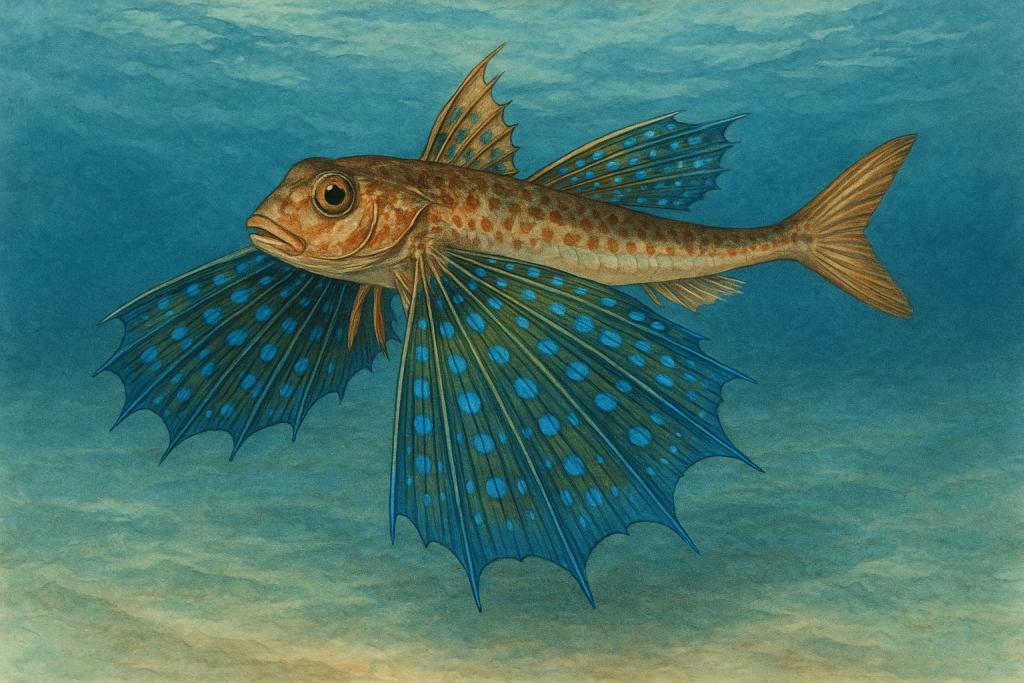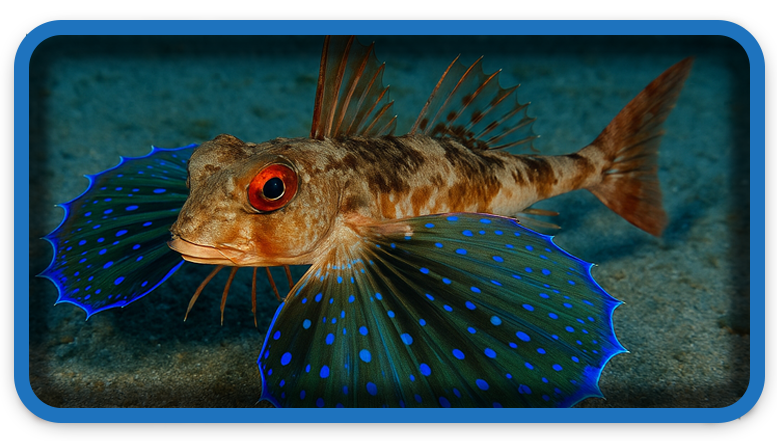⏲️ Estimated reading time: 5 min
Flying Gurnard The Winged Fish of the Ocean. The Flying Gurnard is a fascinating fish that seems to possess wings, captivating divers and marine enthusiasts alike. With its wide pectoral fins, vibrant patterns, and unique behavior, this ocean dweller stands out as one of nature’s aquatic marvels.
Flying Gurnard: The Winged Fish of the Ocean
The ocean is home to countless strange and wonderful creatures, and among them, the Flying Gurnard (Dactylopterus volitans) has earned a special place. Often mistaken for a fish capable of true flight like flying fish, the Flying Gurnard instead uses its enormous, wing-like pectoral fins for a different kind of performance an underwater display of beauty, intimidation, and survival.
In this article, we’ll explore what makes the Flying Gurnard so unique, from its appearance and behavior to its habitat and role in marine ecosystems.

What is the Flying Gurnard?
The Flying Gurnard is a species of bottom-dwelling marine fish belonging to the family Dactylopteridae. Its name comes from its extraordinary pectoral fins, which it can spread like wings. When folded, the fish looks rather ordinary, but when extended, the fins transform it into a spectacular sight earning it the nickname “the winged fish of the ocean.”
Despite its name, the Flying Gurnard doesn’t actually fly. Unlike the true flying fish (Exocoetidae) that leap out of water and glide above the surface, Flying Gurnards remain underwater. Their fins are primarily used for startling predators, attracting mates, and gliding across the seafloor.
Appearance and Unique Features
Flying Gurnards are small to medium-sized fish, typically growing to about 20–50 cm (8–20 inches) in length. Some of their most distinguishing features include:
- Wing-like Pectoral Fins – Their most remarkable trait, which they can spread suddenly to display intricate patterns of blue, green, and purple.
- Armored Body – They are covered in bony plates that provide protection against predators.
- Distinctive Head Shape – With a blunt snout and large eyes, their head gives them an almost prehistoric look.
- Coloration – Their fins have a dazzling iridescent pattern that can appear luminous under water, a useful tool in both mating rituals and defensive displays.
Where Do They Live?
Flying Gurnards are found in tropical and temperate waters around the world, including the Atlantic Ocean, Mediterranean Sea, and the Indo-Pacific region.
- They prefer sandy and muddy bottoms where they can blend in and forage.
- They are often spotted at depths ranging from 10 to 100 meters (33–328 feet).
- They are especially popular among scuba divers in the Caribbean and Indo-Pacific reefs.
Behavior and Feeding Habits
Flying Gurnards spend much of their time at the bottom of the ocean, where they use their lower pectoral fin rays adapted into finger-like appendages to “walk” along the seafloor.
Feeding:
Their diet mainly includes:
- Crustaceans such as crabs and shrimp
- Small fish
- Worms and mollusks
Using their sensitive “fingers,” they probe the sand and mud for prey, uncovering hidden creatures.
Defense Mechanism:
When threatened, they spread their massive pectoral fins to appear much larger than they really are. This sudden, colorful display can frighten predators such as groupers and larger fish.
Do Flying Gurnards Really Fly?
One of the most common misconceptions is that Flying Gurnards leap out of the water and glide like flying fish. In reality, they do not leave the water. Instead, their fins are used in three main ways:
- Intimidation – To scare off predators.
- Mating Displays – To attract potential partners.
- Gliding on the Seafloor – To help them “hop” across the ocean bottom.
This makes them a truly unique case of evolution, where wings exist without the purpose of flight.
The Role of Flying Gurnards in Marine Ecosystems
Flying Gurnards are an important part of the marine food chain. They help maintain balance by preying on bottom-dwelling crustaceans and being a food source for larger predators.
Additionally, their fascinating behavior makes them a favorite subject of marine photography and eco-tourism, particularly in diving hotspots.
Interesting Facts About Flying Gurnards
- They can produce grunting sounds by beating their swim bladder, giving them the name “Gurnard” (from the French word grogner, meaning “to grunt”).
- Their wing-like fins can span up to two-thirds of their body length.
- They are related to scorpionfish and sea robins, both of which also have unusual fin adaptations.
- Despite their intimidating look, they are harmless to humans.
- They can live up to 6–8 years in the wild.
Human Interaction and Conservation
Flying Gurnards are not commercially important for fishing, as their meat is not widely consumed. However, they are sometimes caught as bycatch in nets.
Fortunately, their populations are considered stable, and they are not listed as endangered. Their vibrant appearance and harmless nature make them a fascinating species for divers and researchers alike.
Why the Flying Gurnard Captivates Us
There’s something inherently captivating about creatures that blur the line between different animal worlds. The Flying Gurnard, with its fish body and wing-like fins, evokes the image of a mythical sea dragon or a creature straight out of folklore. Its beauty and uniqueness remind us how little we truly know about the ocean’s depths.
Thoughts
The Flying Gurnard is one of the most fascinating fish in the ocean. With its incredible “wings,” ability to “walk” along the seafloor, and striking colors, it has earned a legendary status among divers and marine enthusiasts. While it doesn’t actually fly, it still inspires awe and wonder, proving once again that nature’s imagination far surpasses our own.
🔔 For more tutorials like this, consider subscribing to our blog.
📩 Do you have questions or suggestions? Leave a comment or contact us!
🏷️ Tags: flying gurnard, winged fish, ocean creatures, marine life, scuba diving, fish, underwater animals, sea exploration, tropical fish, strange fish
📢 Hashtags: #FlyingGurnard, #MarineLife, #OceanCreatures, #ScubaDiving, #ExoticFish, #SeaExploration, #Wildlife, #NatureLovers, #UnderwaterWorld, #OceanWonders
Only logged-in users can submit reports.
Discover more from HelpZone
Subscribe to get the latest posts sent to your email.

